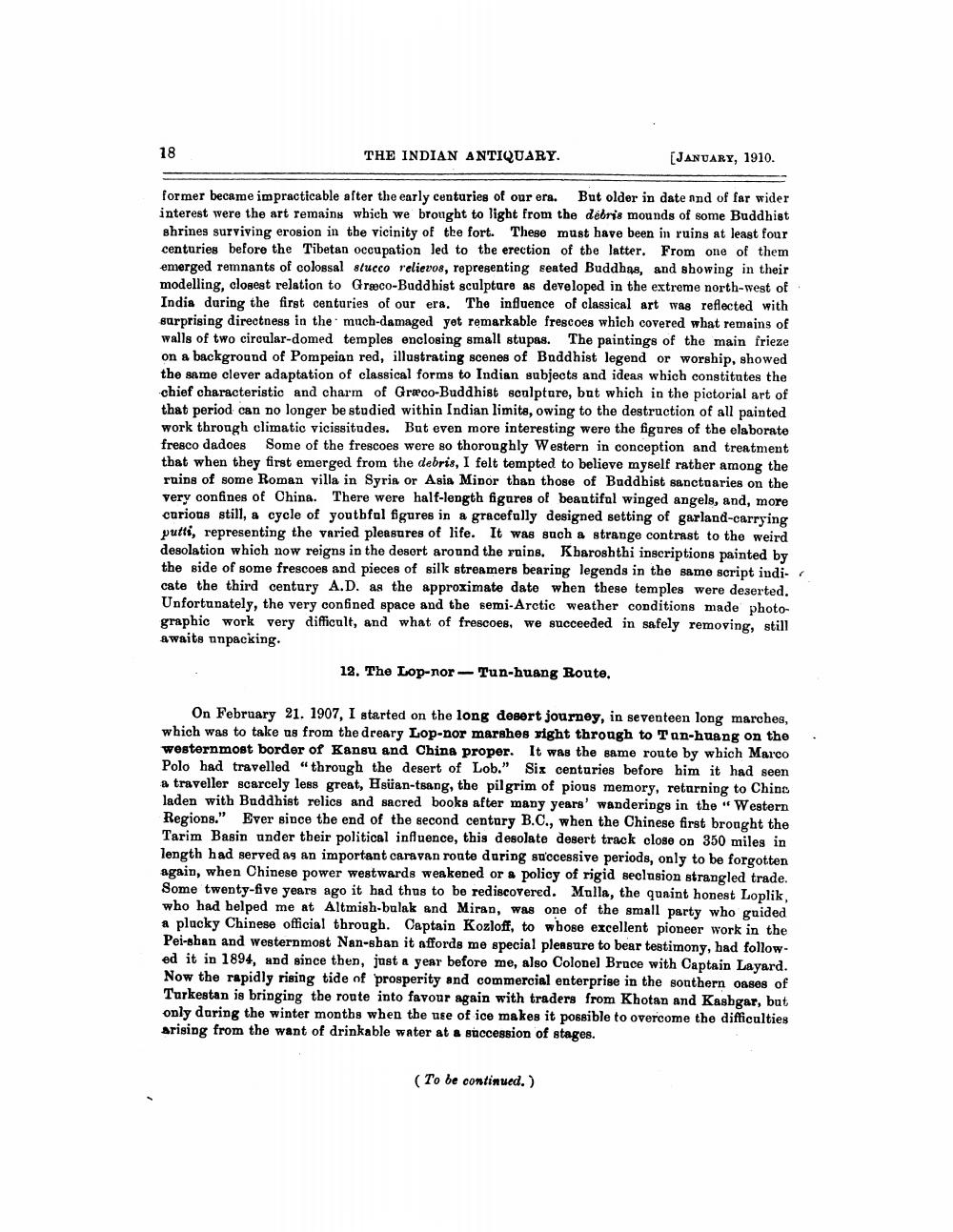________________
18
THE INDIAN ANTIQUARY.
(JANUARY, 1910.
former became impracticable after the early centuries of our era. But older in date and of far wider interest were the art remains which we brought to light from the debris mounds of some Buddhist shrines surviving erosion in the vicinity of the fort. These must have been in ruins at least four centuries before the Tibetan occupation led to the erection of the latter. From one of them emerged remnants of colossal stucco relievos, representing seated Buddhas, and showing in their modelling, closest relation to Græco-Buddhist sculpture as developed in the extreme north-west of India during the first centuries of our era. The influence of classical art was reflected with surprising directness in the much-damaged yet remarkable frescoes which covered what remains of walls of two circular-domed temples enclosing small stupas. The paintings of the main frieze on a background of Pompeian red, illustrating scenes of Buddhist legend or worship, showed the same clever adaptation of classical forms to Indian subjects and ideas which constitutes the chief characteristic and charm of Græco-Buddhist sculpture, but which in the pictorial art of that period can no longer be studied within Indian limite, owing to the destruction of all painted work through climatic vicissitudes. But even more interesting were the figures of the elaborate fresco dadoes Some of the frescoes were so thoroughly Western in conception and treatment that when they first emerged from the debris, I felt tempted to believe myself rather among the ruins of some Roman villa in Syria or Asia Minor than those of Buddhist sanctuaries on the very confines of China. There were half-length figures of beautiful winged angels, and, more curious still, a cycle of youthful figures in a gracefully designed setting of garland-carrying putti, representing the varied pleasures of life. It was such a strange contrast to the weird desolation which now reigns in the desert around the ruins, Kbaroshthi inscriptions painted by the side of some frescoes and pieces of silk streamers bearing legends in the same script indicate the third century A.D. as the approximate date when these temples were deserted. Unfortunately, the very confined space and the semi-Arctic weather conditions made photographic work very difficult, and what of frescoes, we succeeded in safely removing, still awaits unpacking.
12. The Lop-nor-Tun-huang Route.
On February 21. 1907, I started on the long desert journey, in seventeen long marches, which was to take us from the dreary Lop-nor marshes vight through to Tan-huang on the westernmost border of Kansu and Chins proper. It was the same route by which Marco Polo had travelled “through the desert of Lob." Six centuries before him it had seen a traveller scarcely less great, Hsüan-tsang, the pilgrim of pious memory, returning to Chinc laden with Buddhist relics and sacred books after many years' wanderings in the Western Regions." Ever since the end of the second century B.C., when the Chinese first brought the Tarim Basin under their political influence, this desolate desert track close on 350 miles in length had served as an important caravan roate during successive periods, only to be forgotten again, when Chinese power westwards weakened or policy of rigid seclusion strangled trade. Some twenty-five years ago it had thus to be rediscovered. Mulla, the quaint honest Loplik, who had helped me at Altmish-bulak and Miran, was one of the small party who guided a plucky Chinese official through. Captain Kozloff, to whose excellent pioneer work in the Pei-shan and westernmost Nan-sban it affords me special pleasure to bear testimony, had followed it in 1894, and since then, just a year before me, also Colonel Bruce with Captain Layard. Now the rapidly rising tide of prosperity and commercial enterprise in the southern oases of Turkestan is bringing the route into favour again with traders from Khotan and Kasbgar, but only during the winter months when the use of ice makes it possible to overcome the difficulties arising from the want of drinkable water at a succession of stages.
(To be continued.)




